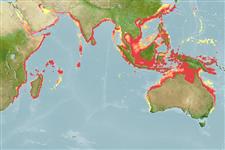>
Eupercaria/misc (Various families in series Eupercaria) >
Sciaenidae (Drums or croakers)
Eponymy: Rev Dr Christoph Samuel John (1747–1813) was a botanist and herpetologist and a medical missionary (1771–1813) at the Danish trading station of Tranquebar (now Tharangambadi), Tamil Nadu, not far from Madras (Chennai). [...] (Ref. 128868), visit book page.
More on author: Bleeker.
Environment: milieu / climate zone / Tiefenbereich / distribution range
Ökologie
seewasser; süßwasser; brackwasser benthopelagisch; tiefenbereich 0 - 132 m (Ref. 57178). Tropical; 30°N - 36°S, 32°E - 155°E (Ref. 56999)
Indo-West Pacific: Persian Gulf eastward to southern China and Taiwan and northern and northeastern Australia and New Guinea.
Length at first maturity / Size / Gewicht / Alter
Geschlechtsreife: Lm 15.9 range ? - ? cm
Max length : 34.8 cm TL Männchen/unbestimmt; (Ref. 55968); common length : 20.0 cm SL Männchen/unbestimmt; (Ref. 9772)
Rückenflossenstacheln (insgesamt) : 10 - 12; Rückenflossenweichstrahlen (insgesamt) : 27 - 32; Afterflossenstacheln: 2; Afterflossenweichstrahlen: 7 - 8. Snout rounded but not swollen or projecting; mouth large, oblique; upper jaw extending backward below posterior half of eye; no barbel on chin; teeth in narrow bands, well differentiated into large and small in both jaws, but none canine-like; gill rakers slender, about half length of gill filaments at angle of arch, 9 to 15 on lower limb. Second anal spine moderately long, 24 to 42 % of head length. Scales on head cycloid (smooth). Swim bladder hammer-shaped, the first pair of arborescent appendages entering head beyond transverse septum and sending a palmate branch to the front of pectoral arch. Sagitta (large earstone) with a tadpole-shaped impression, the head of which has its long axis lying obliquely to that of sagitta and the tail expanded and deepened as a hallow cone connected with the head by narrow groove.
Body shape (shape guide): fusiform / normal.
Inhabits shallow coastal waters, estuaries, and rivers. In India, matures at the size of 14 to 16 cm TL; attains an average size of 15.8 cm TL, 20.6 cm TL, and 24 cm TL, at the end of 1 year, 1.5 years and 2 years, respectively. Juveniles prefer crustaceans and as they grow , show piscivorous tendency (Ref. 9772). Marketed fresh and dried salted (Ref. 3490).
Life cycle and mating behavior
Geschlechtsreife | Fortpflanzung | Ablaichen | Eier | Fecundity | Larven
Sasaki, K., 2001. Sciaenidae. Croakers (drums). p.3117-3174. In K.E. Carpenter and V.H. Niem (eds.) FAO species identification guide for fishery purposes. The living marine resources of the Western Central Pacific. Volume 5. Bony fishes part 3 (Menidae to Pomacentridae). Rome, FAO. pp. 2791-3380. (Ref. 9772)
IUCN Rote Liste Status (Ref. 130435: Version 2025-1)
Bedrohung für Menschen
Harmless
Nutzung durch Menschen
Fischereien: weniger kommerziell
Tools
Zusatzinformationen
Download XML
Internet Quellen
Estimates based on models
Preferred temperature (Ref.
123201): 24.6 - 29.1, mean 28 °C (based on 2424 cells).
Phylogenetic diversity index (Ref.
82804): PD
50 = 0.5000 [Uniqueness, from 0.5 = low to 2.0 = high].
Bayesian length-weight: a=0.00490 (0.00326 - 0.00737), b=3.12 (3.00 - 3.24), in cm total length, based on LWR estimates for this species & Genus-body shape (Ref.
93245).
Trophic level (Ref.
69278): 3.7 ±0.4 se; based on diet studies.
Widerstandsfähigkeit (Ref.
120179): hoch, Verdopplung der Population dauert weniger als 15 Monate. (K=0.5-0.8).
Fishing Vulnerability (Ref.
59153): Low vulnerability (22 of 100).
🛈
